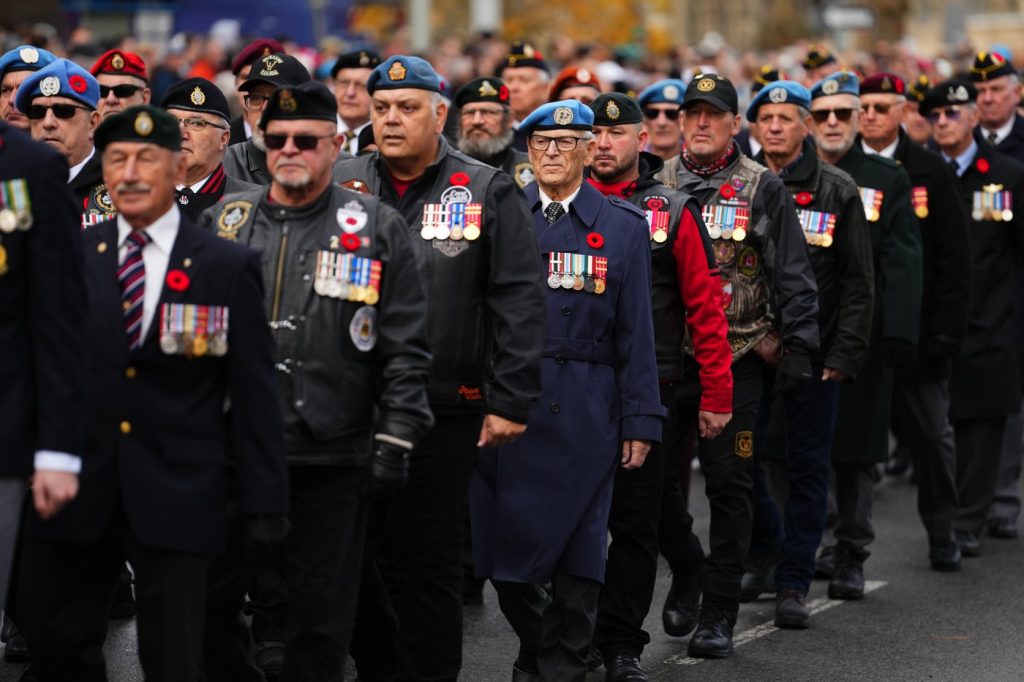Remember This? Canada at war with Japan
Posted Dec 5, 2022 12:40:00 PM.
CityNews, in partnership with the Historical Society of Ottawa, brings you this weekly feature by Director James Powell, highlighting a moment in Ottawa's history.
All those interested in history know the date Dec. 7, 1941.
This was, of course, the date of the surprise Japanese attack on the US naval base at Pearl Harbor in Hawaii. The attack, which commenced shortly before 8:00 am Hawaii time, took the lives of more than 2,300 service people and destroyed or damaged twenty-one US ships. The battleships 'Arizona' and 'Oklahoma' were complete write-offs. Several other battleships were also sunk in the attack though they were later refloated and restored to service. Also destroyed in the attack were almost two hundred US airplanes; scores more were damaged.
As horrific as the loss of personnel and ships and other major assets was, it could have been worse. The aircraft carriers 'Enterprise', 'Lexington' and 'Saratoga', which were stationed at Pearl Harbor, were not in port at the time of the attack.
The next day, in front of a joint session of Congress, US President Franklin D. Roosevelt said that the day was “a date which will live in infamy” since the Japanese government had not declared war before the attack.
The assault was supposed to have occurred a half hour after the Japanese Embassy in Washington D.C. had delivered its declaration of war. But, owing to decoding and translation delays, the diplomatic note was not delivered until after the attack was underway. The United States declared war upon Japan one hour after Roosevelt’s “Infamy Speech.”
While the news of the attack on Pearl Harbor came as a big shock to all—Americans, British and Canadians—few were surprised by the outbreak of hostilities given the deterioration of the political situation in Asia over the previous months. On hearing the news, the United Kingdom quickly declared war on Japan, even before the United States did. In Ottawa, following a Cabinet meeting during the evening of Dec. 7r, Prime Minister Mackenzie King announced the Canadian government’s decision to declare war. King George VI approved Canada’s declaration in a proclamation announced on Dec. 8 1941 but backdated to the previous day.
Whereas by and with the advice of Our Privy Council of Canada We have signified our Approval of the issue of a Proclamation in the Canada Gazette declaring that a State of War with Japan exists and has existed in Canada as and from the 7th day of December 1941.”
One of the more surreal events of that time occurred in Ottawa the evening before the Pearl Harbor attack. As the Japanese naval ships were approaching the Hawaiian Islands and Japanese pilots were being given their last-minute briefings, Seijiro Yoshizawa, the Japanese Minister to Canada, was hosting a sumptuous banquet at the Japanese Residence at 192 Daly Avenue. (The Japanese rented the house from Senator Carine Wilson, Canada’s first woman senator.) Yoshizawa was a career diplomat, and described as a member of the business clique in Tokyo that opposed the army. He had presented his credentials to the Governor General, the Earl of Athlone, in October 1940, replacing Baron Tomii as Japan’s Minister to Canada.
Invited to Mr and Mrs Yoshizawa’s diplomatic soirée were: Commander W. Strother, US Naval Attaché; Mr Lewis Clark, Third Secretary at the US Legation; Mr D. B. Jordan, US Legation; the Brazilian Minister to Canada; the Argentine Minister to Canada; the Argentine First Secretary; the Commercial Councillor for Brazil; and S Kanaya of the Japanese Legation. All were accompanied by their wives. The Japanese also invited two Canadian couples—Mr and Mrs E. F. Newcome, KC and Mr and Mrs J. G. MacPhail.
Guests were courteously greeted at the door of the Residence by white-coated servants who passed around Martini and Bacardi rum cocktails along with canapés and other hors d’oeuvres. Sherry was served with the opening course, a clear asparagus consommé with a soupçon of carrot. This was followed by white fish, garnished with lobster and washed down by a slightly chilled sauterne. A dry burgundy and a sherry were served with the next course—breast of chicken and stuffed tomatoes. The meal concluded with a strawberry mousse accompanied by French Champagne.
After the sumptuous meal, Yoshizawa played eight reels of coloured film that he had personally taken of that year’s fall colours at Kingsmere and at the Seigniory Club at Montebello. Meanwhile, waiters circulated amongst the guests, serving orangeade, or something stronger if requested.
According to attendees at the dinner, the evening’s conversation avoided politics and the situation in the far east, focusing instead on inconsequential, inoffensive subjects. Some felt uncomfortable to be there. While the Japanese were always courteous, and entertained lavishly, there was a growing disinclination to accept invitations, given their relationship with Nazi Germany and Fascist Italy, and their war in China. However, it was sometimes difficult to say no; there are only so many excuses one could give. For some, especially the Americans, attendance was virtually a diplomatic necessity given the strained circumstances.
In hindsight, one of the guests described the dinner party “as something out of a dream” as it had a disturbing feeling of unreality. It was likened to the 1939 Hollywood movie 'Idiot’s Delight', a comedy drama that starred Clark Gable and Norma Shearer. The film featured events in a fictious Alpine country on the day before war was declared. (The movie is notable for being the only film in which Clark Gable sings and dances.) Another guest called it the “dinner of destiny,” one that could not have occurred twelve hours later.
With a state of war existing between Canada and Japan, the office of the Japanese Legation in Ottawa located on the sixth floor of the Victoria Building on Wellington Street closed immediately. Its lights were turned out and telephones disconnected. An RCMP officer was stationed outside of the Legation office to keep away the curious.
There was a report that on Dec. 7, immediately prior to the Peral Harbour attack, Yoshizawa and three others had left the Legation office with three large bags, contents unknown. An employee in the building also recalled seeing bits of charred paper floating in the street just a few days before. Given what happened in Hawaii, he surmised that embassy staff had been burning documents.
With the Legation’s offices closed, reporters flocked to the Japanese Residence on Daly Avenue seeking a statement from Yoshizawa. However, they were met at the door by a polite official who told them that while the Minister was home, he was not speaking to the press. Through the windows, the reporters could see staff packing.
The next issue was how to get the Japanese officials back to Japan and, conversely, Canadian diplomats stationed in Japanese territory back to Canada. Previously, diplomats of newly belligerent countries were sent to a neighbouring neutral country to travel home. However, with the United States also at war, this was no longer an option. In a radio broadcast, Prime Minister King said that the passports of the Japanese Legation and consular officials would be returned as soon as satisfactory arrangements had been made for the safe return of Canadian diplomatic staff in the far east.
Meanwhile, Yoshizawa and his colleagues were under RCMP guard—reportedly more for their own safety rather to prevent them from doing something nefarious. They were permitted to move about Ottawa, as long as they were accompanied. However, they were not allowed to communicate with anybody outside of the city. The big question now was money. With their bank accounts frozen, the Japanese officials had to rely on credit, but who would be willing to extend credit to them? There was also the issue of outstanding bills. Mrs Yoshizawa had her hair done the day before the attack on Pearl Harbor and had asked for the bill to be sent to the Legation. There were also the monthly rent payments owed to Senator Wilson. The Canadian government told creditors to be patient. Frozen Japanese assets would be used to cover such expenses.
The declaration of war also meant the Legation’s Canadian chauffeur lost both his job and his home, an apartment in the Legation Residence. Jack Long, who had won a DCM in the World War I, doubted his ability to find another job that compared as well to the one he had had for more than twelve years with the Japanese.
It wasn’t until early May 1942 that the Japanese Legation staff left Ottawa. Six months to the day from the Pearl Harbor attack, RCMP guards escorted twenty Japanese diplomats to Union Station to catch the evening CNR train to Montreal from whence they would travel through the United States, presumably meeting up with Japanese officials departing from that country, to leave North America. How they did so is not clear though they most likely travelled to still neutral Mexico which did not enter the war against the Axis powers until May 22, 1942. Senator Wilson subsequently rented the now vacated Japanese Legation at 192 Daly Avenue to the Norwegian Legation and Military Mission.
Canadian diplomats in Tokyo were treated in a similar fashion to the Japanese diplomats in Ottawa. The staff at the Canadian Legation was headed by E. D’Arcy McGeer, the first Secretary and Chargé d’affaires, as the post of Canadian Minister to Japan had been unfilled since the resignation of Robert R. Bruce in 1938. McGeer and his staff of seven were confined to the Canadian Legation’s grounds while awaiting repatriation and were only allowed out with an escort. McGeer said that the Japanese authorities made sure that they had adequate food. Indeed, he believed that the food’s quality was superior to that available to most Japanese citizens. McGreer and his companions left Japan on in July 1942 on the Japanese steamer Asama Maru bound for Lourenco Marques in neutral Portuguese East Africa (now Mozambique), the first leg on the arduous and dangerous trip back to Canada.
Years later after the war, then External Affairs Minster Lester B. Pearson visited Tokyo for preparatory talks to re-establish diplomatic relations between Canada and Japan. There, he met three former Japanese Ministers to Canada, including Seijiro Yoshizawa. Pearson said it was something like a home reunion. The Japanese ex-ministers wanted to know the latest Ottawa gossip and asked Pearson about people they had known in Ottawa, golf and other activities they had enjoyed during their pre-war postings in Canada.
Full diplomatic ties between Canada and Japan were re-established with the San Francisco Peace Treaty of 1952.








